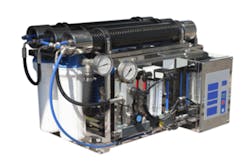Important factors to consider for RO systems
Sept. 16, 2014
2 min read
BIRMINGHAM — In Water Technology’s September feature, "Pretreating RO systems can enhance membrane operation and longevity," Assistant Editor Maria Woodie writes about pretreating water for reverse osmosis (RO) systems.
In the article Cris Lemay, regional sales manager for Graver Technologies, and Henry Avina, vice president of business development for AXEON Water Technologies, suggest a few factors to consider regarding RO systems:
- Determining particle size and concentration aids in selecting suitable microfiltration prior to the membrane.
- Organics might not be picked up in a particle analysis or Silt Density Index test; a broad analysis, such as GC, can be valuable for waters with already installed membranes, varying water sources or known concerns with the water — for example, difficulty cleaning and/or short life.
- There is no set standard on what determines filter ratings; if a high quality or high efficiency filter is used as a prefilter, it reduces the load on the membrane. The cost may be greater, but so will the operative lifecycle.
- "One size fits all" should not be a universal rule regarding pretreatment/prefiltration.
- Feed water temperature can considerably affect RO production; for example, the difference between treating water at 40° F compared to 77° F, will decrease production capability by 37.5 percent.
- The future need of system productivity is often overlooked due to users providing only what they need initially. Systems capable of expansion may raise initial cost, but it will help lower future operational expenses.
- Cleaning membranes regularly can expand the performance of the membrane, but this should not be a substitute to pretreatment.
You can read the entire feature on RO system pretreatment and maintenance here.
About the Author
Sign up for our eNewsletters
Get the latest news and updates
